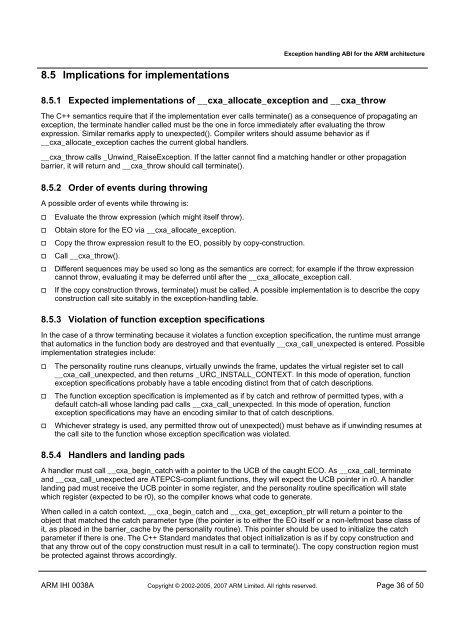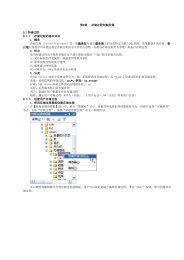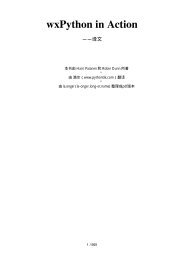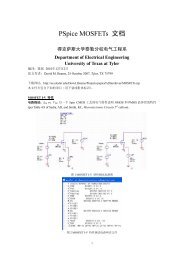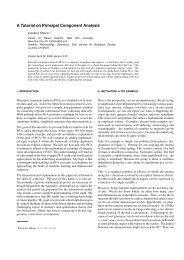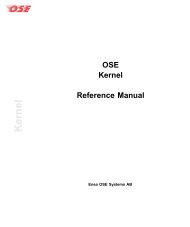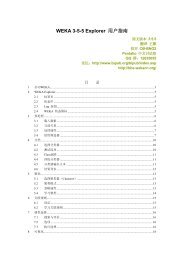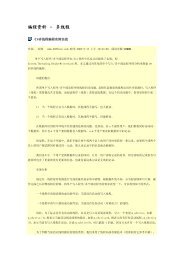Exception Handling ABI for the ARM Architecture
Exception Handling ABI for the ARM Architecture
Exception Handling ABI for the ARM Architecture
You also want an ePaper? Increase the reach of your titles
YUMPU automatically turns print PDFs into web optimized ePapers that Google loves.
<strong>Exception</strong> handling <strong>ABI</strong> <strong>for</strong> <strong>the</strong> <strong>ARM</strong> architecture<br />
8.5 Implications <strong>for</strong> implementations<br />
8.5.1 Expected implementations of __cxa_allocate_exception and __cxa_throw<br />
The C++ semantics require that if <strong>the</strong> implementation ever calls terminate() as a consequence of propagating an<br />
exception, <strong>the</strong> terminate handler called must be <strong>the</strong> one in <strong>for</strong>ce immediately after evaluating <strong>the</strong> throw<br />
expression. Similar remarks apply to unexpected(). Compiler writers should assume behavior as if<br />
__cxa_allocate_exception caches <strong>the</strong> current global handlers.<br />
__cxa_throw calls _Unwind_Raise<strong>Exception</strong>. If <strong>the</strong> latter cannot find a matching handler or o<strong>the</strong>r propagation<br />
barrier, it will return and __cxa_throw should call terminate().<br />
8.5.2 Order of events during throwing<br />
A possible order of events while throwing is:<br />
<br />
<br />
<br />
<br />
<br />
<br />
Evaluate <strong>the</strong> throw expression (which might itself throw).<br />
Obtain store <strong>for</strong> <strong>the</strong> EO via __cxa_allocate_exception.<br />
Copy <strong>the</strong> throw expression result to <strong>the</strong> EO, possibly by copy-construction.<br />
Call __cxa_throw().<br />
Different sequences may be used so long as <strong>the</strong> semantics are correct; <strong>for</strong> example if <strong>the</strong> throw expression<br />
cannot throw, evaluating it may be deferred until after <strong>the</strong> __cxa_allocate_exception call.<br />
If <strong>the</strong> copy construction throws, terminate() must be called. A possible implementation is to describe <strong>the</strong> copy<br />
construction call site suitably in <strong>the</strong> exception-handling table.<br />
8.5.3 Violation of function exception specifications<br />
In <strong>the</strong> case of a throw terminating because it violates a function exception specification, <strong>the</strong> runtime must arrange<br />
that automatics in <strong>the</strong> function body are destroyed and that eventually __cxa_call_unexpected is entered. Possible<br />
implementation strategies include:<br />
<br />
<br />
<br />
The personality routine runs cleanups, virtually unwinds <strong>the</strong> frame, updates <strong>the</strong> virtual register set to call<br />
__cxa_call_unexpected, and <strong>the</strong>n returns _URC_INSTALL_CONTEXT. In this mode of operation, function<br />
exception specifications probably have a table encoding distinct from that of catch descriptions.<br />
The function exception specification is implemented as if by catch and rethrow of permitted types, with a<br />
default catch-all whose landing pad calls __cxa_call_unexpected. In this mode of operation, function<br />
exception specifications may have an encoding similar to that of catch descriptions.<br />
Whichever strategy is used, any permitted throw out of unexpected() must behave as if unwinding resumes at<br />
<strong>the</strong> call site to <strong>the</strong> function whose exception specification was violated.<br />
8.5.4 Handlers and landing pads<br />
A handler must call __cxa_begin_catch with a pointer to <strong>the</strong> UCB of <strong>the</strong> caught ECO. As __cxa_call_terminate<br />
and __cxa_call_unexpected are ATEPCS-compliant functions, <strong>the</strong>y will expect <strong>the</strong> UCB pointer in r0. A handler<br />
landing pad must receive <strong>the</strong> UCB pointer in some register, and <strong>the</strong> personality routine specification will state<br />
which register (expected to be r0), so <strong>the</strong> compiler knows what code to generate.<br />
When called in a catch context, __cxa_begin_catch and __cxa_get_exception_ptr will return a pointer to <strong>the</strong><br />
object that matched <strong>the</strong> catch parameter type (<strong>the</strong> pointer is to ei<strong>the</strong>r <strong>the</strong> EO itself or a non-leftmost base class of<br />
it, as placed in <strong>the</strong> barrier_cache by <strong>the</strong> personality routine). This pointer should be used to initialize <strong>the</strong> catch<br />
parameter if <strong>the</strong>re is one. The C++ Standard mandates that object initialization is as if by copy construction and<br />
that any throw out of <strong>the</strong> copy construction must result in a call to terminate(). The copy construction region must<br />
be protected against throws accordingly.<br />
<strong>ARM</strong> IHI 0038A Copyright © 2002-2005, 2007 <strong>ARM</strong> Limited. All rights reserved. Page 36 of 50


